NEWS LETTER
November 2025

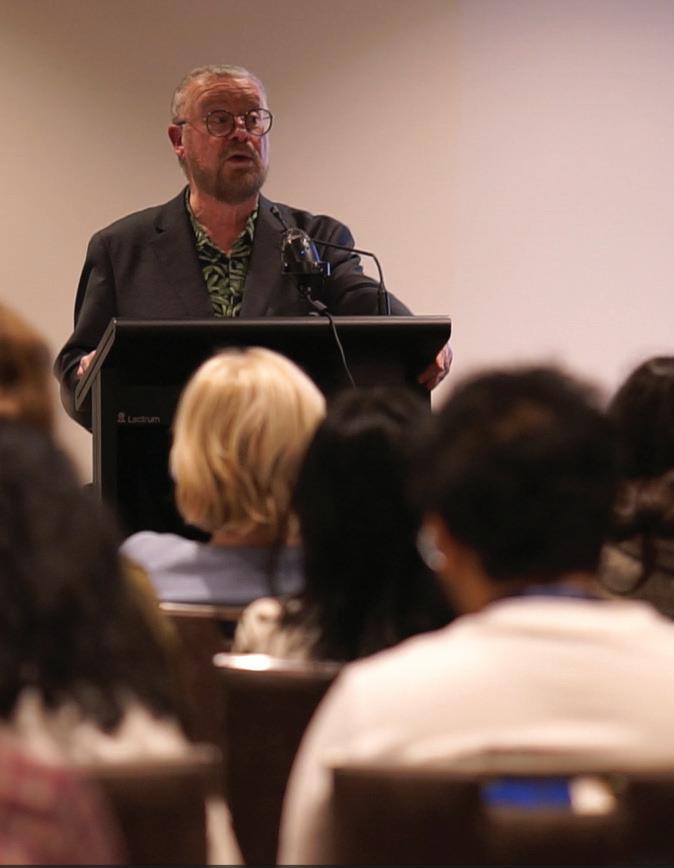




November 2025





Professor Mary Galea on The Order of Malta: “Our mission to care for the poor and the sick is a lesson for everybody”
On 1st October 2025, at the Graduate House Monthly luncheon, many members and guests attended a presentation by Professor Mary Galea, AM, FAHMS.
Mary Galea was made a Member of the Order of Australia (AM) in the 2019 Australia Day Honours for “significant service to medical education in the field of clinical physiotherapy, and to professional associations”. She is a Professorial Fellow in the Department of Medicine at the University of Melbourne. Her research in basic and clinical neuroscience has contributed to understanding the organisation and development of the motor system, as well as its recovery from injury. She is also a member of the Australian Association of the Order of Malta, the Order of Malta, and the Order of Australia Mercy Palliative Care Volunteer Program Steering Committee.
Her presentation began with the idea that the Order of Malta has an uninterrupted history dating back to the Crusades and even earlier, making it a 970-year-old organisation. The Order was originally born in Jerusalem, then made its way to Cyprus, then Rhodes, then Malta and now Rome. When did the journey start? Well everything started when merchants from the Republic of Amalfi, with permission of the Caliph of Egypt, decided to establish a church, a convent and hospital for
pilgrims who visited the Holy Land. This hospital was dedicated to St John the Baptist. After the recognition of The Order by the Pope in 1113, it fell under the protection of the church.
The eight-pointed cross was their symbol and it is recognised until this day as the cross of Malta or the Cross of St John. The eight points symbolise the Beatitudes within the order.
Even though the Order started with medical purposes, at one point the Order had to become a military, to protect the pilgrims being attacked on their way to the Holy Land. So as well as looking after the sick and the poor, and managing the medical centres, they also started guarding the roads, and so they assumed the role of defenders of the Christian states. Around that time, the Order had a period of expansion, as they started building fortresses and hospitals, many of those still remain. After the fall of Jerusalem, the members of the Order took refuge in the Jordan Valley, and then they withdrew further north to Syria, finally taking refuge in Cyprus.
From Cyprus, the knights developed a navy to defend their territory in the Mediterranean from the Ottomans. At this point, to secure the future of the organisation, they overtook Rhodes, which became a bastion of Christendom in the eastern Mediterranean, and the place where the order became a naval power.

The Ottoman Empire kept rising, and the Order was greatly outnumbered, having only 6,000 soldiers against 200,000 fighting for Suleiman the Magnificent. After surrendering to Suleimam, and being pardoned and allowed to leave with full honors, the Order found itself without a landing point and went to various places seeking a home, until King Charles of Spain decided to give them Malta to establish themselves.
During the Great Siege of 1565, which lasted from May 18 to September 8, the Ottoman forces had 373 vessels and 40,000 men, while the Order’s forces had 500 Knights and 9,000 soldiers, including the Maltese. Despite the incredible difference between both military forces, the Ottomans were finally defeated at the Battle of Lepanto in 1571, showcasing the Order’s resilience and strategic importance in the Mediterranean.
After this important success, the Order received support from various European nations to start building a proper city. In this more stable position, the Order was able to focus on its original mission of tending to the sick, and Malta became a very renowned medical area.
We also learnt about the time that Napoleon took over Malta as part of the French campaign on the Mediterranean in 1798, and how the island
was finally freed by the British in 1800. Under the British occupation of Malta the Order had to move again. During the Protestant Reformation, some knights decided to become Protestants, initiating new Orders still recognised by the Order of Malta.
In the end, the headquarters of the Order were set in Rome until today.
In Mary’s own words, “what’s very interesting about this Order is that it always calls people in need, “our Lords”. In other words, the members of the Order are there to serve the sick and the poor, so they take precedence. In the end, the service is directed towards the people that need us most, and we’re their servants”.
“I think our mission to care for the poor and the sick is a lesson for everybody, because that doesn’t happen anymore. There’s such a huge divide between wealthy and poor and people discarded, as if they don’t matter. And that’s the problem in war zones too. We can see that in Gaza now, and we can see it in lots of other places as well... but by showing the example of caring, hopefully will mean a lot in the end. It is something. I think for us as ordinary citizens, showing care for the people around us is really the action that speaks louder than words”.
Thank you Mary, for a very interesting luncheon.

On Thursday 16th of October, we received Dr Ted Gott, Senior Curator of International Art at the National Gallery of Victoria (NGV) for the last Twilight lecture of 2025. Dr Gott talked to us about the detective role of a curator. Beyond the more known tasks of a curator like looking after the permanent collections, organising displays and preparing thematic exhibitions, curators often encounter mysteries that require what Dr Gott calls “the art of detection”. We learned about the importance of it through the particular case of a painting by Louis Duffy, a virtually unknown artist whose painting style and motifs captivated our speaker and other curators at the Gallery. But it was not until the gallery acquired one of his pieces that Dr Gott’s detective work began. The following is a condensed version of Dr Ted Gott’s lecture.
During a trip to Wellington’s Museum of New Zealand Te Papa Tongarewa in 2006, with a colleague from the NGV, Laurie Benson, we encountered a remarkable painting by the artist Louis Duffy, named Casualty no. 1. The painting
depicts a common sight in London during the Blitz of 1940 to 1941, a rescue squad of the ARP (Air Raid Precautions). Wearing overalls and steel helmets marked with a distinctive R, a team rescues a survivor from a bombed site. Until this discovery, we had never heard of Louis Duffy, but were so struck by his work that we decided to include it in our NGV exhibition at that time about Modern Britain.

in September 2006, another one of his paintings appeared for auction in London. Titled Christ turning out the money changers, this piece was undated and the artist himself was listed as 20th Century, clearly showing how little information about the artist was known, even to Sotheby’s. So the NGV decided to purchase the piece as an addition to the permanent collection, thanks to the funds of generous donors Bruce Parncut and Robin Campbell.
This impressively large painting (that measures more than one by one and a half meters), shows sixteen men gathered in intense confrontation, in a modern day retelling of the New Testament account of Christ expelling the money changers from the temple. In this rendition, the temple is transformed into a graveyard, and the money changers into 20th century arms dealers trading ammunitions on the graves of the dead. The Christ character is a handsomely burly protagonist, stripped to his undershirt and wielding a truncheon.
The New Testament account of Christ and the money changers has been depicted regularly in Western art since medieval times. The mayhem breaking out here, ammunition traded in a churchyard, presents an even stronger dialogue about the immoral nexus of avarice, war and corruption. The standoff between the central pair of figures, Christ and the devil, good and evil, could easily be read as a metaphor for Chamberlain and Churchill versus Hitler. You can see that the devil’s fingers are tensed with aggression and sport remarkable talons like those seen on demons in Trecento Italian panel paintings. The replacement of Christ’s traditional whip with a sturdy truncheon adds a further dimension to Duffy’s powerful anti-war allegory. Such allusions, along with considerations of the male dress in the painting, led us to propose a date of around 1940 for the work.
Once at the NGV, and before a much needed and extensive restoration of six months to take off a layer of shellac covering the painting, the piece was
analysed with x rays and infrared photography by John Payne, one of the conservators at the NGV. This examination of the work revealed no under drawing and very minimal compositional changes during the painting process; at that moment it was clear that this unknown artist was a master of his craft.
In the search for details that could provide more information about the painting’s original name and Louis Duffy himself, the frame of the painting provided the first clue. After careful analysis, we were able to identify the manufacturer: Alfred Stiles and Sons, who was preferred by modernist artists. Also, a surviving label on the painting stretcher, was inscribed in pen and ink in period handwriting, reading: passenger train. Louis C. Duffy, 23 St Mary’s Road, Leamington, Warwickshire.
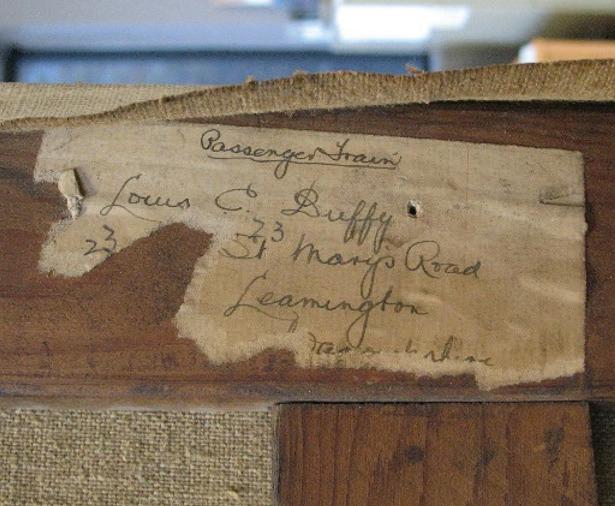
Through this information we were able to identify that Louis Duffy had presented two works in the summer exhibitions of London’s Royal Academy of Arts: Military Objectives (1943), which we thought may have been the original title for the piece at the NGV, and Quiet Farm (1945). We also discovered that in 1942, two of Duffy’s paintings were included in a publication about war pictures by British artists in a booklet by Oxford University Press. One of these was Casualty no. 1, the first piece we discovered in New Zealand. In 2007, thanks to a publication by Brian Foss, we were able to identify
Aftermath (1940), located at the Laing Art Gallery. In both works, Duffy reflected the dichotomy of powerlessness and stoic resistance experienced by Britain’s civilian population during the war.
An opportunity that arose for me to visit the United Kingdom in 2008, allowed me to pick up the Duffy trail in Leamington Spa, Warwickshire. There, the Art Gallery Museum’s records show that Duffy had resided in Leamington Spa between 1939 and 1944, presumably living most of the time at Saint Mary’s Road. He was listed in the archives as a painter, designer, mural decorator, mosaic artist and craftsman.
After the conclusion of hostilities, thousands of art works that were commissioned by the WAAC (War Artists Advisory Committee) were gifted to London’s Imperial War Museum, galleries in the UK, and to allied governments in the Commonwealth. That’s how Casualty no. 1 ended up in Wellington.
I was able to see three other Duffy paintings at the Imperial War Museum in London, where they keep them in storage. These works reveal Duffy’s fascination with the many forms of camouflage production and research being undertaken in Leamington Spa, where he was part of the Directorate of Camouflage. One of these depicted concealment netting strung above an access way.
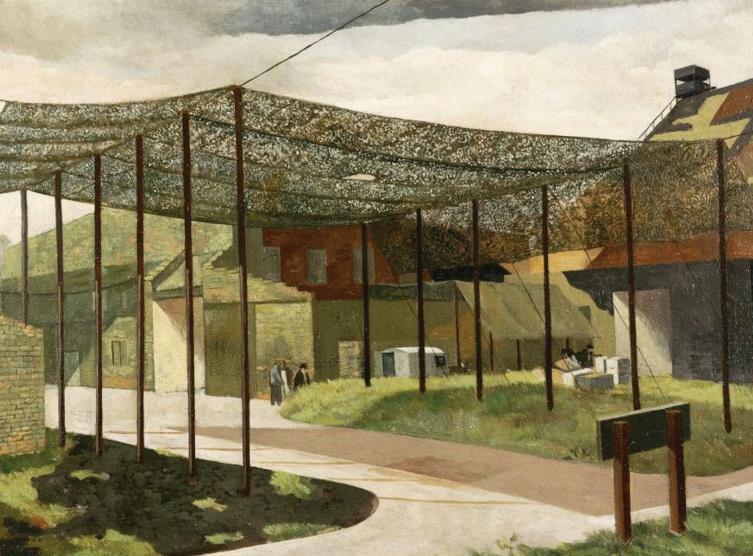
An internet search of the British Artist’s Papers Register at this time also led me to London’s
Science Museum, where I discovered that Duffy worked throughout the 1960s, completing a series of canvases measuring approximately three metres by seven metres that were subsequently installed as murals, which remain in situ today in the museum’s shipping and marine engineering galleries. He worked at the museum as late as 1982, when his correspondence indicated he was living in Seaford, a seaside town in East Sussex. This enabled a likely identification of the artist with Lewis Charles Duffy, who died in Eastbourne in March 1998 at the age of 89, providing life dates for our artist from 1908 to 1998. Louis Duffy was thus 31 years old at the outbreak of the Second World War, and 74 years of age at the time of his last documented work for the Science Museum. And the Science Museum archives now brought to light the first image of our artist, painting one of their murals.

Duffy’s pieces had been exhibited twice at the Royal Academy London. These works, which followed the idea of translating biblical themes into modern terms, coined him a review in The Times, describing his work as intriguing. Despite all this new information on the artist and his work, back in Australia we were still unable to identify our piece. Back in Melbourne in 2010, the NGV worked with a group of highly creative teenagers to produce a series of short films posted on the web that looked at various aspects of behind the scenes at the
gallery. I participated in one of these, called Art Detective. In that interview, I told how I had found Louis Duffy’s death certificate through the British Probate Office, showing his life dates 1908 to 1998, and how on this certificate, there was listed the address of a relative in England, a Judith Aibara, to whom I’d written. I was hoping, I said, to come into work one day and find a letter saying, this is my father, or this is my uncle, Louis Duffy. Thanks to the miracle of the internet, dreams do come true these days. In early 2011, I received an email from Darius Aibara, Judith’s son and Louis Duffy’s grandson, saying that Judith had relocated from Belfast to West Sussex in 2006. Her cousin, however, had seen the Art Detective film on the NGV’s website, and the family tom-tom drums began to beat.
I was able to visit Judith and Darius in West Sussex, who generously shared their family archives with me, most especially Louis Duffy’s period photographs of his own works. Thanks to his family back in West Sussex, and a family member here in Melbourne, I was able to reconstruct Louis Duffy’s life from the day his parents got married, his birth in India, and his studies at Manchester Municipal School of Art and the École des Beaux-Arts in Paris.
After his studies, Louis worked for the Catholic church painting portraits, drawings and possibly mosaics. I was able to find many other photographs of his war time paintings. By this time I had been able to track some notices of the 1942 Royal Academy exhibition where Duffy had shown Military objectives, the one I had mistakenly thought might be the original name of the painting we had at the NGV.
Press articles described a completely different painting of a woman with a baby in her arms, identifying a body which lies under a white sheet. Miraculously, the Aibaras had a photograph of this tragic and moving painting, allowing me to see Duffy’s Military objectives for the first time.
Now, if all of these Louis Duffy Blitz works could be located today and the series reconstituted, imagine how it would inform our understanding of the terror experienced by Britain’s civilians at this time. It’s a truly remarkable series of paintings, and I do hope the other four we see here turn up one day.
Finally, here with the Aibaras was a photograph of the Agony in the Garden shown at Grundy Art Galleries in Blackpool in 1945, and its companion piece, the NGV’s own painting inscribed Blackpool (1945), and thus revealing itself to be not Military objectives, but the work shown in Blackpool as Buyers and Sellers. As if this wasn’t enough, Louis Duffy’s photo archive contained meticulous drawings, revealing the extraordinary preparation that enabled him to paint his Buyers and Sellers in such an assured manner, with no compositional changes other than to that tiny scrap of paper in the composition’s foreground.
Now, one other painting leapt out at us. Judith Aibara recalls how, following the evacuation of hundreds of thousands of Allied troops from Dunkirk in May 1940, many soldiers came to the hospital at Leamington Spa for treatment. This is when Lewis Duffy painted this work, Head of a Soldier from Dunkirk. This heroic soldier, whose name we do not yet know, served as a fitting model for the Christ figure in the NGV’s Christ Evicting the Money Changers, which we’ve now correctly renamed Buyers and Sellers.
Now, Jules de Sain’s classic 1958 film, Naked City, ended with the words, “there are eight million stories in the naked city. This has been one of them”. So I’d like to close by saying that there are 80,000 stories behind the works of art held by the National Gallery of Victoria, and this has been one of them. Thank you.
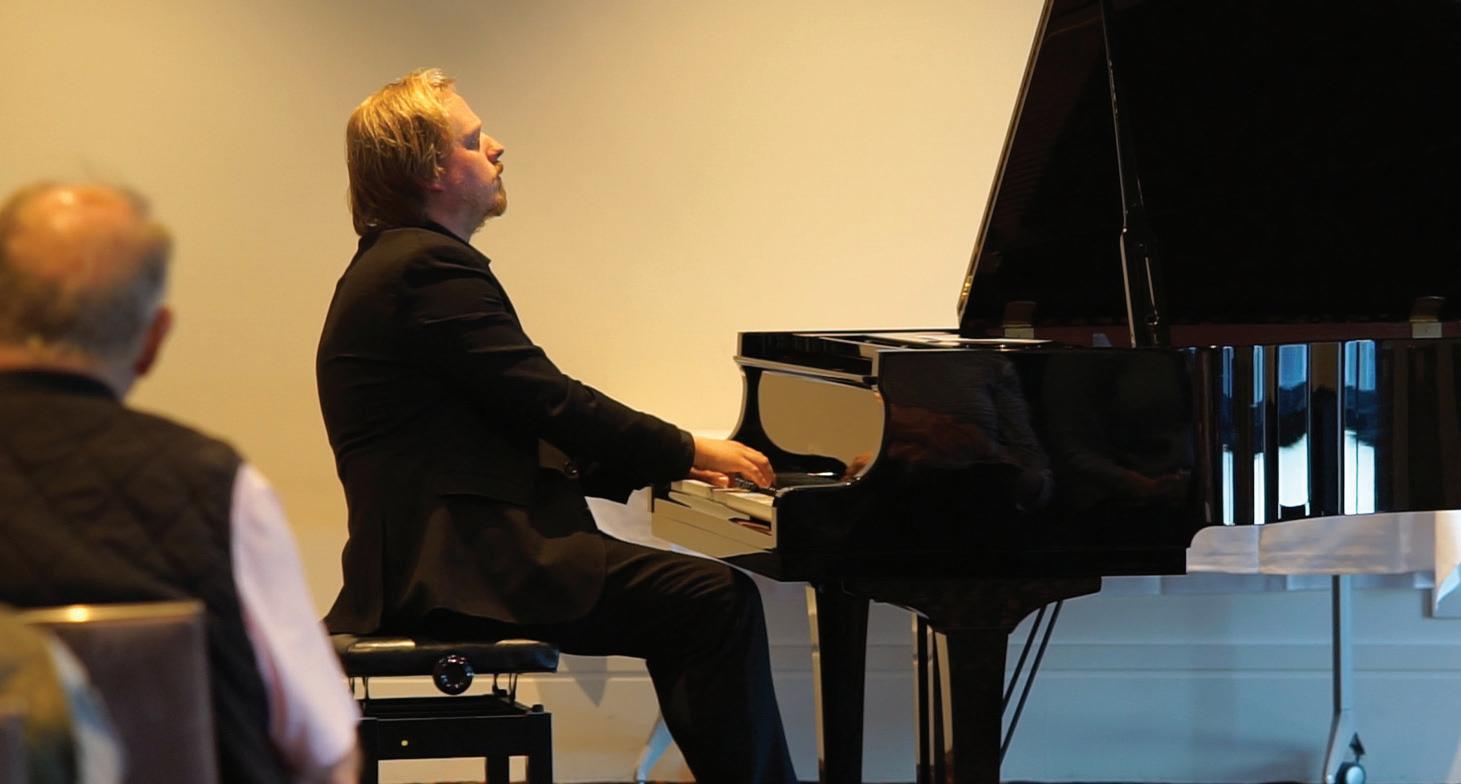
On Thursday 16th of October, Graduate House received 3MBS Radio and pianist Konrad Olszewski for a superb lunchtime recital.
Konrad delighted attendants with a great selection of pieces that showcased his masterful skills on the piano. With a program that included Mozart’s Rondo in D Major, Schubert’s Four Impromptus, and Chopin’s Rondo in E-Flat Major and Waltzes, among other of the artists favourites, he amazed all attendees and offered an incredible performance in the last recital of 2025 at Graduate House.
We thank our friends at 3MBS Radio for partnering with us to offer our and their members a fantastic musical experience.
We will be meeting again in 2026 to present more renowned performers in this fantastic opportunity to enjoy a some of the best musicians in Melbourne at Graduate House. So, if you love an excellent classical performance, be on the lookout for our next year’s program.
Wednesday, 12 th November


Time: 12:00pm for 12:30pm start
Online login: 1:10pm for 1:15pm start
Jon Faine AM is a VC Fellow at UoM, based in the Melbourne Law School but with a remit to range across the entire universit y. Until October 2019 Jon was the host of the agenda-setting morning broadcast for ABC Radio in Melbourne for over twenty years. Before joining the ABC in 1989 to host ‘ The Law Repor t ’ on Radio National, Jon had practised for seven years in both commercial litigation and as a legal aid/human rights advocate at Fitzroy Legal Service. He has published books such as “Apollo & Thelma; A True Tall Tale” (2022), and the bestselling travel book, “From Here to There” (2012).
In The Disordered Mumblings of a Failed Shock Jock, he presents an unorthodox and candid exploration of contemporary issues. Known for his thought-provoking approach to current affairs.
In this unscripted seminar, Faine will reflect on the pressing social, political, and cultural challenges of the day, drawing from his personal and professional experiences. This lecture provides a rare opportunity to engage with Faine’s raw and unfiltered insights.
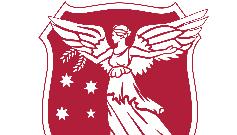

Prices: To Book:
Members $42, non-members $47, Residents $15
Virtual: Members $10, non-members $15
Call: 03 9347 3428
Email: admingh@graduatehouse.com.au
*Luncheon includes welcome drinks and a two course meal with wine, tea and coffee

Staff, Members of the Council, Members and residents gathered for a heartfelt morning tea to celebrate the retirement of Rosie, our muchloved Hospitality Manager, after an incredible 32 years of service to Graduate House. The event was filled with laughter, stories, and plenty of emotion as colleagues past and present came together to honour her remarkable contribution.
Rosie’s service to Graduate House will always be cherished by the countless members and guests she served and helped with the organisation of
events. In the words of Graduate House’s General Manager, Daniel Clark, “we just want to say thank you for everything, and you will be missed. Thank you for your laughter, your smile, your dedication, your kindness and everything else you gave to the Graduate Union over your years here. We wish you all the best and please know that you will always have a home and a family here at Graduate House”.
Rosie gave a heartfelt farewell speech, where she talked about her history at Graduate House. We would like to share her words with all of our members.
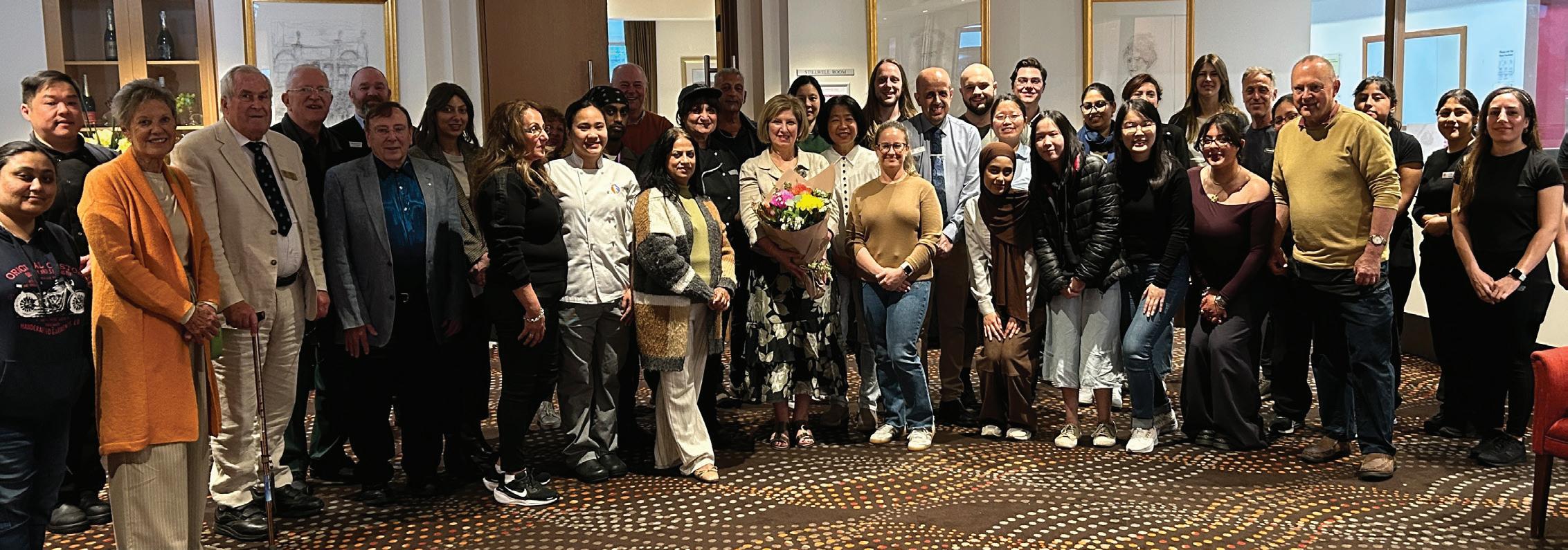

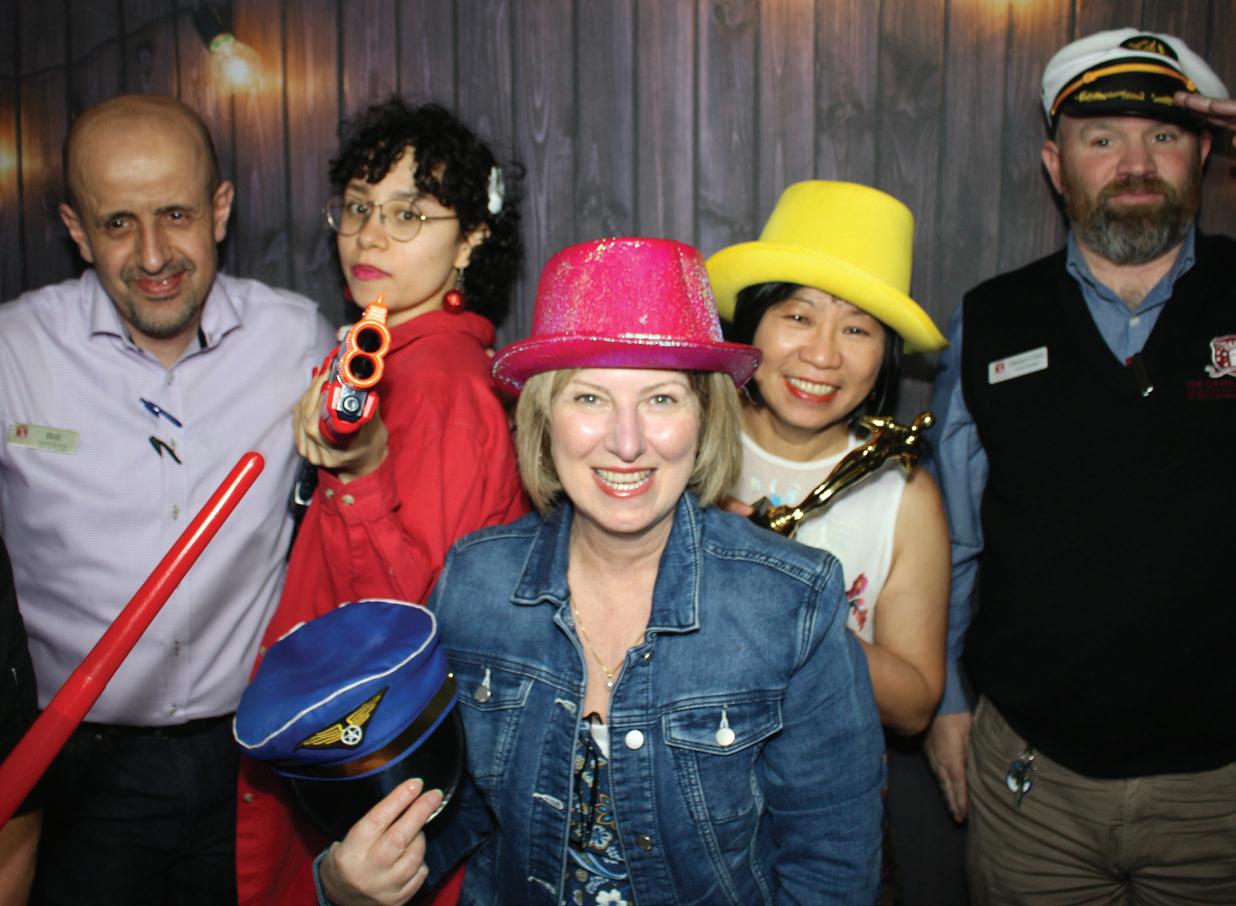
“Thank you all so much for being here today to celebrate my retirement, it means so much to me. Standing here now I feel a mix of sadness, happiness and a bit of disbelief that 32 years have passed so quickly.
Graduate House has always held a special place in my heart and in my mother Nina’s as well. For those who don’t know, she worked here from the 1970s through to the 1990s as a domestic worker. Between the two us we have shared more than fifty years of memories within these walls.
Little did I know when I walked through these doors in 1993 that Graduate House would become my second home. Back then, we accommodated just 40-50 residents and now we welcome around 150.
Over the decades I have grown personally and professionally – so I’d like to take a few moments to reflect on my journey.
From 1993-2004 – I worked on a casual basis in the Kitchen, housekeeping, waitressing and the office. I got to experience and appreciate different roles in the house.
In 2005 I stepped into catering and conference supervision and in 2007 moved into a full time role. Those years taught me leadership, along with a passion for hospitality and customer service.
Since 2011 – I’ve had the privilege of serving as Hospitality Manager – working with clients, booking meetings and functions and working closely with the hospitality team. Together we have hosted and catered for countless events. I will always remember discussing our weekly running sheets, brief and debrief on a daily basis, and refining menus. I’m so grateful to my team for their hard work and to our clients for their loyalty and support over the years.
Some of my fondest memories are of our inhouse events with our past and present members and residents – from monthly luncheons to the
Chairman’s cocktail party and of course our famous Christmas in July celebrations, complete with DJ, photobooth and plenty of dancing. Those moments of laughter and connection are ones I will treasure forever.
I have also witnessed significant changes here. In the early 2000s, we saw the demolition of Kidd’s Warehouse which was between the Terraces houses to make way for the Main House, followed a few years later by the redevelopment of the Stella Langford Wing. These projects reflected a vision for growth, welcoming more postgraduate residents and meeting delegates while also creating new opportunities for staff.
The most challenging time we faced was the Covid 19 pandemic. It was especially difficult watching residents leave suddenly for home and seeing our bookings vanish almost overnight. Luckily by late 2021, bookings started coming in and we could again start to see some normality.
To all my colleagues, past and present, thank you for your friendship, support and shared memories. Together we have experienced a lot of challenges, laughter and tears. You have supported me during my time here and I will always cherish the memories we have shared.
I’d also like to offer a special thank you to Mr Clark. You have been a wonderful manager and always having a positive attitude. I enjoyed sharing an office with you for many years. I am very grateful for your support, especially IT support, and always making time for my questions and listening to me vent. Thank you for everything you have done for me. It has been a privilege to work alongside you.
Over the decades, I have been fortunate to meet so many members, residents and staff who in their own way, have contributed to the Graduate Union to make it what it is today. I wish you all the best and especially wish The Graduate Union every success with its exciting major projects ahead.”
A
The Graduate Union Council has recently welcomed two new members: Professor Sally Male and Laurice Asmar.
Professor Sally Male is the Director of The Teaching and Learning Laboratory in the Faculty of Engineering and IT at The University of Melbourne. She is a Fellow of Engineers Australia, Editor-inChief of the Australasian Journal of Engineering Education, and a former Governance Board Member of the Engineering Institute of Technology. Along with this remarkable experience in her field, Sally has vast experience in governance, which she will bring to the table of the Graduate Union Council.
Laurice Asmar is an experienced change management lead with over 15 years of experience. She has worked for NAB, Australian Super, Country Fire Authority, Australian Red Cross and ANZ, leading different successful change projects in these organisations.
Both of them join the Council in a key moment for the Graduate Union, when we keep moving forward on the Stage 1 Project. We are sure that with the addition of their expertise, we will be able to deliver an even stronger project for the Graduate Union.


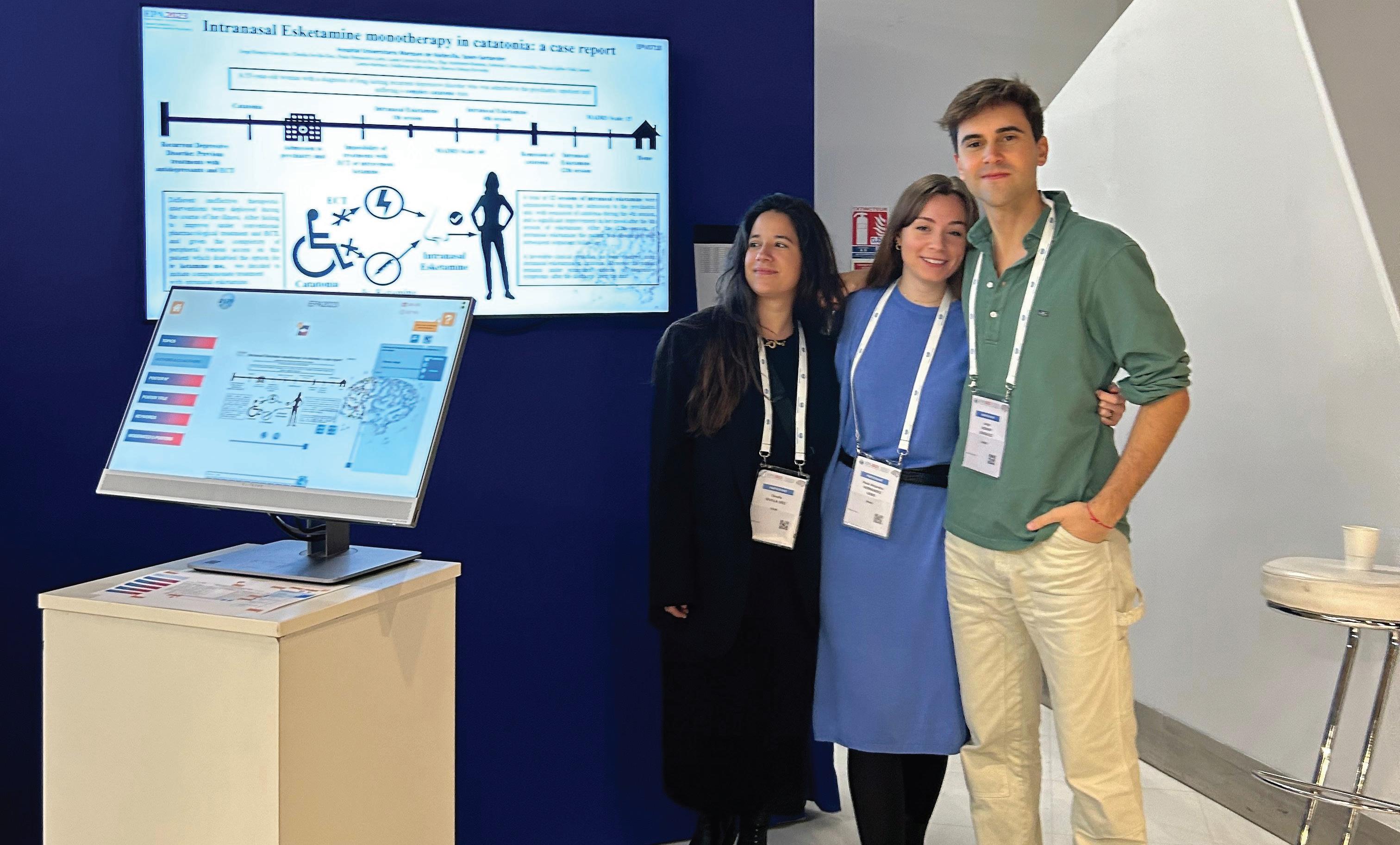
Faces of the Graduate Union is a newsletter series that began in September 2025, with the first piece on Graduate Union member and resident, Sarah Cohen.
Jorge Romay, a Spanish psychiatrist from Gran Canaria, explores the intersection of first-episode psychosis and autism, studying how neurodevelopmental differences shape vulnerability and complicate diagnosis. His goal is to refine early detection, improve differential diagnosis, and design more compassionate, personalized care.
“Outside of work, I stay connected to my roots in the Canary Islands—its culture, landscapes, and warm, resilient spirit. My journey from Gran Canaria to my current projects reminds me that science is ultimately a human endeavour: we advance by listening carefully, questioning openly, and working together to improve people’s lives.”
For him, the Graduate Union has been a home away from home. “The community’s diversity of perspectives—across disciplines and cultures—constantly challenges my assumptions and strengthens my work. I’m grateful for the conversations that begin over coffee and end with new ideas, methods, and friendships.”

By Martin Comte and Max Stephens
Following the success of last year’s Pilot Mentoring Program, we offered a longer program this year. Open to both residents of Graduate House and members of the Graduate Union, the aim was ‘to improve residents’ experience of living and studying in Graduate House and in Melbourne.’ The program, which operated from May through to October, was not specifically aimed towards career mentoring. We were delighted with the response from both resident students and members interested in embarking on the program. The diversity of interests and experience of all involved with particularly pleasing.
At the introductory meeting, mentors and mentees were invited to share their interests and what they hoped to achieve through their involvement in the program. Meeting arrangements, and the number of meetings, were left to each ‘pairing’ to work out. As with last year, different approaches to the experience were evident.
Following the introductory meeting, another ‘midway’ session was held for all of those involved to give feedback and share ideas, activities and any issues. The final ‘sharing’ session, in October highlighted the experiences of each mentor and mentee as well as offering valuable feedback for the program in 2026. A formal evaluation submitted by each participant was most encouraging. Some (paraphrased) highlights of comments received were:
• “The overall experience was great. I greatly appreciated the opportunity to make ‘connections’ [and] having discussions on the culture of Australia.”
• “My mentee introduced me to WhatsApp so that we could continue the connection.”
• “One topic we discussed that I found most helpful was dealing with ‘disappointment’ and ‘frustration’. And as an ‘older’ person, I enjoyed seeing things from a younger person’s perspective”.
• “We developed a very positive relationship and will continue to stay in contact on a wide range of issues. Topics of conversation ranged from current
situations my mentee encountered to restaurant dining and issues relating to English academic writing.”
• “My mentor was warm, kind and very helpful: it was always a pleasure to meet with her. We discussed daily life, how to relax and balance study and leisure, and I received some extremely helpful advice in relation to connecting with my industry. I developed a sense of ‘belonging’ and will recommend the program to my friends.”
• “Overall the experience was great – but I had too many study commitments to take full advantage of the program. I appreciated a discussion about being a PhD student and ways of progressing in academic life.”
• “A very pleasant experience. Connecting with students and with each other and sharing experiences was most valuable.”
• “I learnt a lot about myself and my mentor. Topics of discussion centred on life, leadership, identity, purpose, confidence and personality. It was an excellent experience – exactly the type of experience I was looking for. I cannot be more grateful.”
• “I appreciated coming to understand my mentee’s lived experience and the context for today’s generation of young graduate students.”
Opinion varied as to the optimal length of such a program – from 3 months to 6 months. A major lesson we learnt was the importance of stressing on both mentors and mentees the importance of ‘regular’ meetings.
Our thanks to all involved in the program. The appreciation expressed by our Graduate House residents was loud and clear. This program was especially valued by international students who saw their mentor as someone with whom they could discuss day-to-day issues. A special thanks also to the mentors – all Graduate Union members – who volunteered their time and commitment so generously.
By Martin Comte and Max Stephens
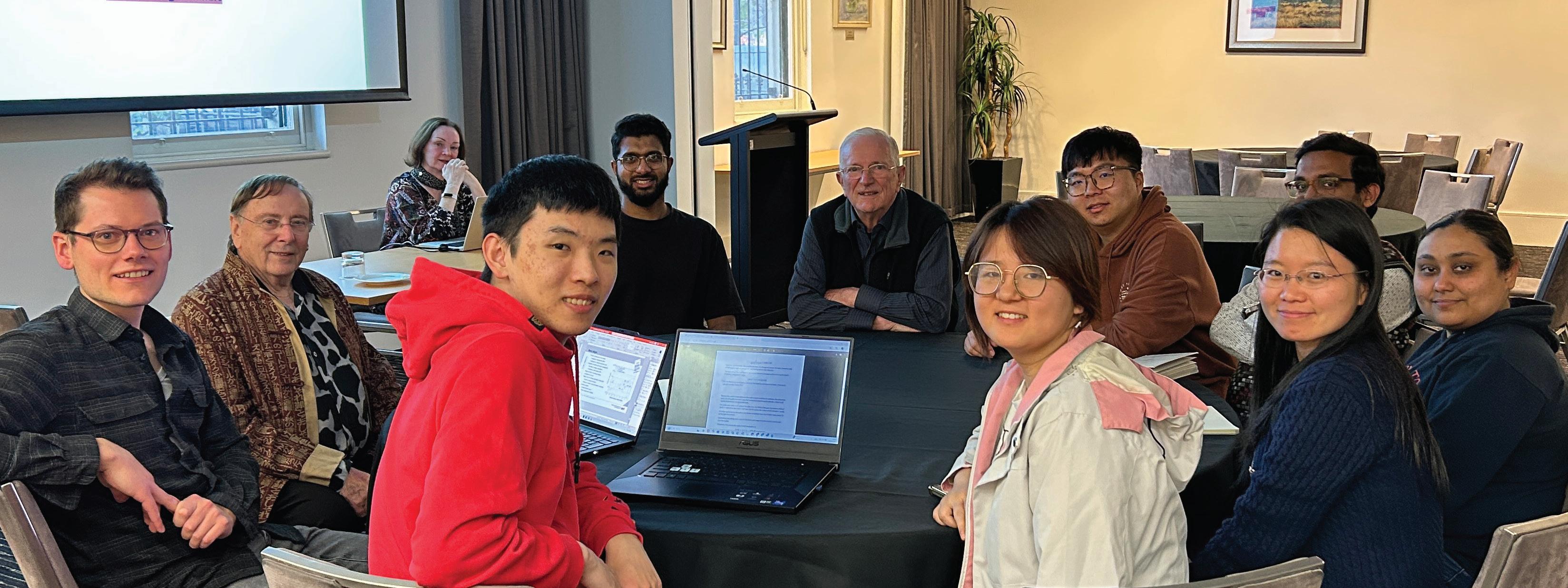
Following the success of our writing seminars and workshops conducted in the previous two years, we again offered another series in Semester 2 this year. Although having relevance for PhD students, the seminars this year focused primarily on Masters degree students. Feedback was sought from those attending regarding what they would like to see addressed. Designed to be relevant across discipline areas, these seminars were concerned with:
• writing academic papers and communication within and across disciplines
• preparing conference abstracts and papers
• preparing and writing for oral presentations
• preparing a cv for various opportunities, and
• job applications
These sessions included presentations and support from council members Martin Comte and Max Stephens, former Graduate House resident, Dr. Mary Ellis, and Emerita Professor Heather Fehring from RMIT University.
Feedback suggested that the series could have been longer – and we will aim to do this next year.
Evaluations like the following were typical:
• “This was a very helpful workshop series. I wish I had attended something like this when I was doing my undergraduate degree. The information provided was very comprehensive.”
• “Examples of terms and expressions to use in scientific writing were really helpful.”
• “This was great. Thank you!”
• “I would have loved to have more sessions.”
• “It was a very worthwhile experience and I appreciate Graduate House for providing it.”
In their feedback the students also made several valuable suggestions that we intend implementing next year. This included increasing the number of sessions, suggesting other topics they would like discussed, and giving students writing exercises to be undertaken in the class.

We learned with regret of the death of David Bellair and Wal Reid, who passed on Saturday 18th October. The Graduate Union appreciates the support of its members throughout their lives and extends condolences to their families.
Families are assured of a continued warm welcome to Graduate House.
We acknowledge all members who have passed and welcome families to notify us.
David Bellair (1942-2025)
Joined 1965
On Council 1992-2004
Chairman 2001-2004
Wal Reid (1934-2025)
Joined 1978
Member of Fundraising and Benefactions
Working Party from 2016
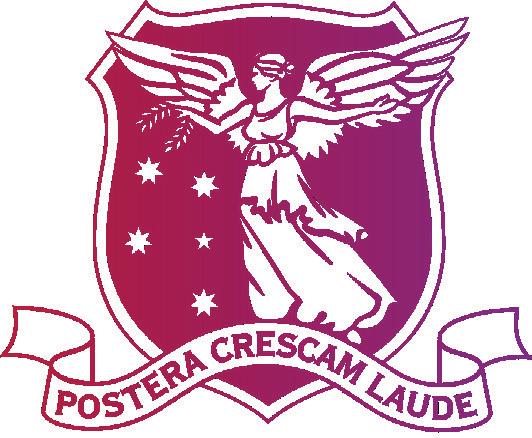
of The University of Melbourne Inc.
220 Leicester Street, Carlton, Victoria 3053, Australia
Telephone: +61 (0)3 9347 3428
Australian Business Number: 55 610 664 963
Incorporated Association Registration Number: A0023234B